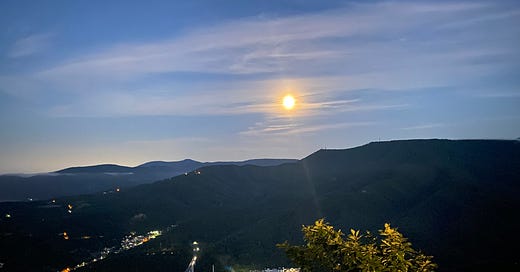As I share my journey in becoming a home owner in Japan and building a life here (mostly at https://vagobond.substack.com and in the Baoism Discord) - I want to make sure that people understand that all of this is happening because I have not only instigated it with intention, but also meditated on it, visualized it, and actualized it.
These cycles of the moon, these silly holidays, and the embracing of these practices into your daily life are the means of creating the life you know you were meant to live. While I encourage no one to take it too seriously, it is incredibly serious if you allow it to be.
The upcoming full moon on August 19, 2024, should hold special significance for those who follow the syncretic spiritual philosophy of Baoism. This event is not just any full moon but a convergence of multiple lunar identities and cultural observances, making it a powerful moment for reflection and connection.
This full moon is known as a supermoon, a term coined by astrologer Richard Nolle in 1979 to describe a full moon that occurs when the moon is at or near its closest point to Earth. Supermoons appear larger and brighter in the sky, offering a striking visual display. This particular supermoon is also a Blue Moon, an occurrence that happens when there are four full moons in a season, with the third being designated as a Blue Moon. Although it won't appear blue, its rarity adds to its mystique.
The August full moon carries various names, each rooted in different traditions. In the northeastern United States, the Algonquin tribes called it the Sturgeon Moon, as this was the time of year when these large fish were most readily caught in the Great Lakes. Other names include the Red Moon, Corn Moon, Barley Moon, and Grain Moon, reflecting the agricultural cycles and natural changes observed during this period.
This full moon also coincides with significant cultural festivals. In Hinduism, Raksha Bandhan, or Rakhi Purnima, is celebrated, emphasizing the bond between siblings. Sisters tie a rakhi, or protective bracelet, around their brothers' wrists, symbolizing their enduring relationship. In Israel, the full moon marks Tu B'Av, a day of love and affection, akin to Valentine's Day in the Western world. This alignment of lunar events with cultural practices provides a moment to honor these traditions and their deep-rooted connections to the lunar cycle.
As the moon reaches its peak at 2:26 PM EDT on August 19, it will be visible across different time zones, from Nepal to Australia. The moon will appear full for about three days, from Sunday morning through early Wednesday morning, offering ample opportunity to observe and reflect on its significance.
This period is also a favorable time for stargazing and planetary observation. Saturn, at its closest and brightest, will be a highlight, especially through a telescope where its rings and bright moon, Titan, can be seen. Two minor meteor showers, the Aurigids and the September Epsilon Perseids, will also peak during this lunar cycle, offering an additional spectacle for those in darker, rural areas.
As you prepare for this significant full moon, consider engaging in reflective practices that align with the spiritual and cultural meanings attached to this event. Whether observing the supermoon, participating in Raksha Bandhan, or simply enjoying the night sky, this is a time to connect with the broader cycles of nature and the enduring traditions that give them meaning.
Be Happy! Do something to celebrate!






